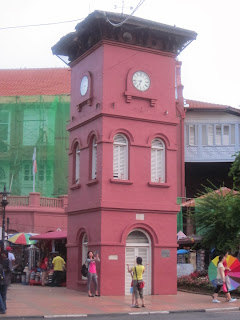(Pic Istana)
 |
| Detail on Porta de Santiago (CNB 2013) |
The Portuguese led by Alfonso de Albuquerque came in 1511 and the Melaka Sultanate fell. Sultan Mahmud Shah went on to found the Johor Sultanate from Kota Tinggi. The fort A 'Famosa built by the Portuguese and taken over by the Dutch who invaded Melaka in 1641, was destroyed by the English in 1806 except for the Porta de Santiago (gate), saved by Stamford Raffles, who was visiting at the time. It is among the the oldest surviving European architectural remains in Asia.
 |
| At the iconic Porta de Santiago (BB 2013) |
A recent discovery while excavating at the site to build the modern Taming Sari Tower is of the Middelsburgh Bastion, a structure part of the fort built to safeguard the Malacca River. This is probably the second most important watch tower after the Santiago Bastion.
 |
| The clock tower fronting the Stadthuys (CNB) |
During the 183 years of their rule, the Dutch left behind many structures, the most outstanding being those in the Dutch Square - the salmon red/pink buildings of the Stadthuys, the clock tower, the Christ Church (1753), etc. The Stadthuys, housing the town hall and governor's residence then, was built between 1641 and 1660. This Dutch colonial structure now houses five museums. Unfortunately at this time, renovations are taking place, so the building is closed. Still, the other buildings in the complex make for great snapshots.
 |
| The St Paul's Church ruins (CNB 2013) |
 |
| Dutch grave stone detail (CNB 2013) |
2-5 November 2013

No comments:
Post a Comment